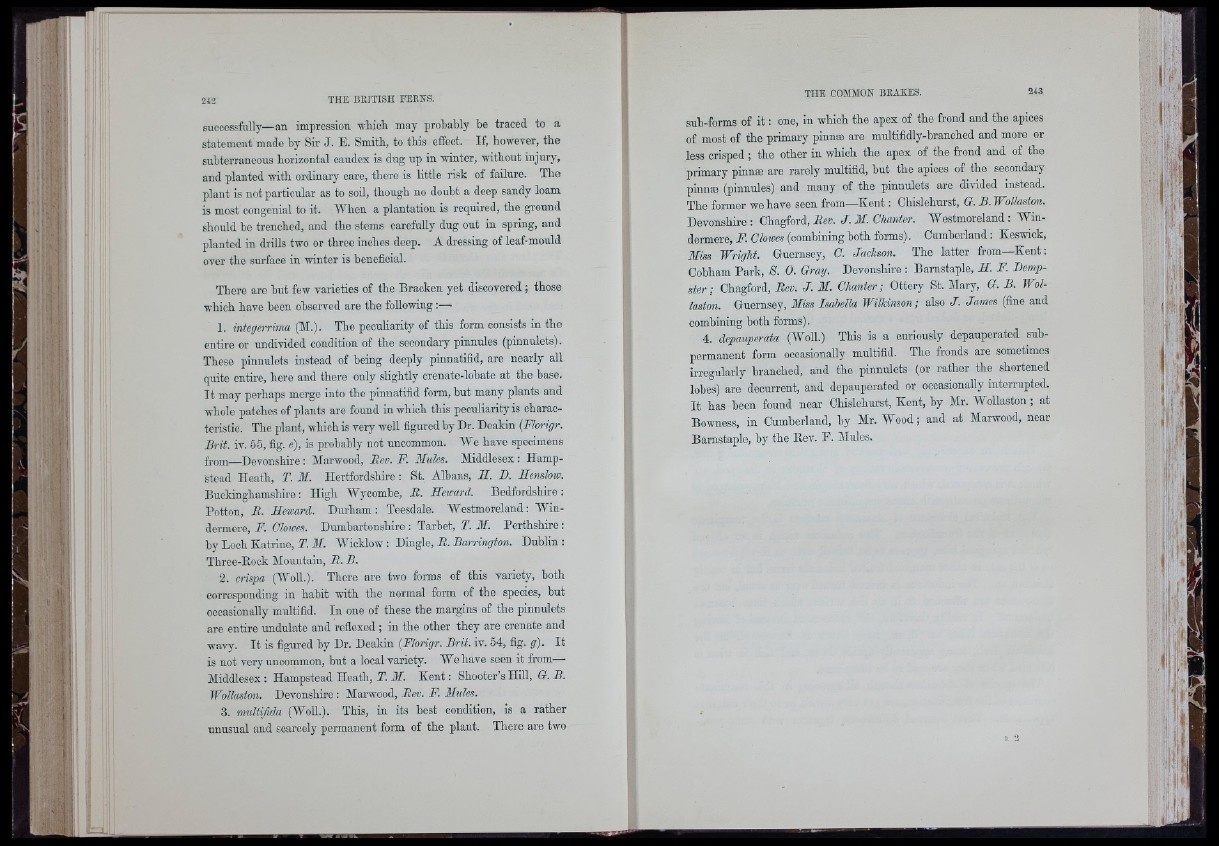
sucocssfull)’—an impression which, may prohahly he traced to a
statement made bj« Sir J. E. Smith, to this effect. If, however, the
subterraneous horizontal caudex is dug up in winter, without injury,
and planted with ordinary care, there is little risk of failure. The
plant is not particular as to soil, though no doubt a deep sandy loam
is most congenial to it. When a plantation is required, the ground
should ho trenched, and the stems carefully dug out in spring, aud
planted in drills two or three inches deep. A dressing of leaf-mould
over the sm-faoe in winter is beneficial.
There are hut few varieties of the Bracken yet discovered ; those
which have been observed are the following
1. integerrima (M.). The peculiarity of this form consists in the
entire or undivided condition of the secondary pinnules (pinnulets).
These pinnulets instead of being deeply pinnatifid, are nearly all
quite entire, here and there only slightly orenate-lobate at the base.
It may perhaps merge into the pinnatifid form, but many plants and
whole patches of plants are found in which this peculiarity is characteristic.
The plant, which is very well figured by Dr. Deakin (Florigr.
Brit. iv. 56, fig. e), is probably not uncommon. We have specimens
fi-om—Devonshire: Marwood, Bev. F. Mules. Middlesex : Hampstead
Heath, T. M. Hertfordshire : St. Albans, 3 . B. Henslow.
Buckinghamshire: High Wycombe, R. Howard. Bedfordshire:
Potton, B. Heward. Durham: Teesdale. Westmoreland: Windermere,
F. Cloices. Dumbartonshire : Tarbet, T. M. Perthshire:
by Loch Katrine, T. M. Wicklow : Dingle, R. Barrington. Dublin :
Three-Eock Mountain, R. B.
2. crispa (Woll.). There are two forms of this variety, both
corresponding in habit with the normal form of the species, but
occasionally multifid. In oue of these the margins of the pinnulets
are entire undulate and reflexed ; in the other they are crenate and
wavy. It is figured by Dr. Deakin (Florigr. Brit. iv. 64, fig. g). It
is not very uncommon, but a local variety. We have seen it from—
Middlesex : Hampstead Heath, T. M. Kent: Shooter’s Hill, G. B.
Wollaston. Devonshire: Marwood, Rev. F. Mules.
3. multifida (Woll). This, in its best condition, is a rather
unusual and scarcely permanent form of the plant. There are two
sub-forms of it : one, in which the apex of the frond and the apices
of most of the primary pinnæ are multifidly-branohed and more or
less crisped ; the other in which the apex of the frond and of the
primary pinnæ are rarely multifid, hut the apices of the secondary
pinnæ (pinnules) and many of the pinnulets are divided instead.
The former we havo seen from—Kent : Ohislehurst, G. B. Wollaston.
Devonshire : Ohagford, Rev. J. M. Chanter. Westmoreland : Windermere,
F. Clowes (combining both forms). Cumberland : Keswick,
Miss Wright Guernsey, C. Jackson. The latter from—Kent:
Cobham Park, S. 0. Gray. Devonshire : Barnstaple, H. F. Benip-
ster; Chagford, Bev. J. M. Chanter; Ottery St. Mary, G. B. Wollaston.
Guernsey, Miss Isabella Wilkinson ; also J . James (fine and
combining both forms).
4. depauperata (Woll.) This is a curiously depauperated suh-
pormanent form occasionally multifid. The fronds are sometimes
irregularly hranohed, and the pinnulets (or rather the shortened
lobes) are deourront, and depauperated or occasionally interrupted.
It has been found near Chislehurst, Kent, by Mr. Wollaston; at
Bowness, in Cumberland, by Mr. Wood ; and at Marwood, near
Barnstaple, by the Eev. F. Mules.
I. 11
' i 'l
Iff
..
V.-fl
•:4"''
îl
■ V, ,
: 1 i|
: 'iijj